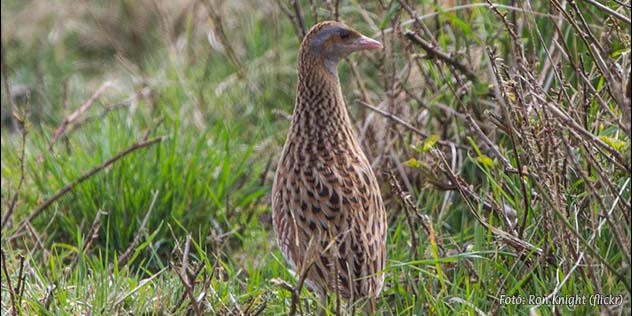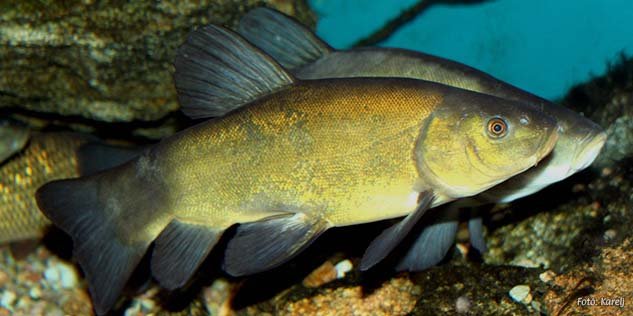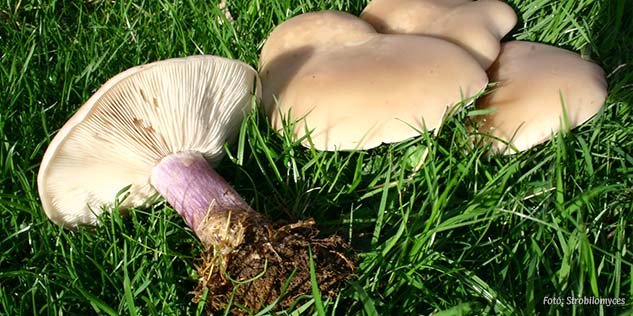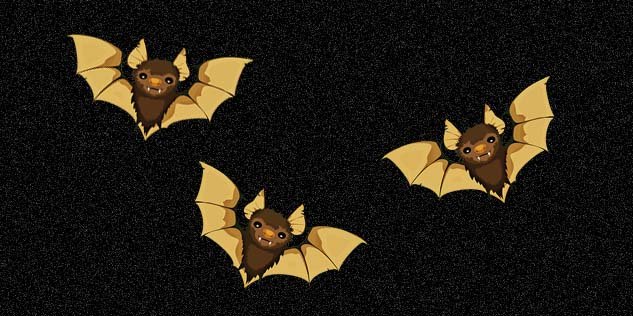
The corn crake or landrail (Crex crex) is a bird in the rail family. It breeds in Europe and Asia as far east as western China, and migrates to Africa for winter. The corn crake is a medium-sized bird with buff- or grey-streaked brownish-black upperparts, chestnut markings on the wings, and blue-grey underparts with rust-coloured and white bars on the flanks and under the tail. The strong bill is flesh-toned, the iris is pale brown, and the legs and feet are pale grey. The male's call is a loud krek krek, from which the scientific name is derived. The corn crake's breeding habitat is grassland, particularly hayfields, and it uses similar environments as its wintering grounds. This secretive species builds a nest of grass leaves in a hollow in the ground and lays 6–14 cream-coloured eggs which are covered with reddish-brown blotches. These hatch in 19–20 days, and the black chicks fledge after about five weeks. This crake is in steep decline across much of its former breeding range because modern farming practices often destroy nests before breeding is completed. The corn crake is omnivorous but mainly feeds on invertebrates, the occasional small frog or mammal, and plant material including grass seed and cereal grain. Natural threats include introduced and feral mammals, large birds, various parasites and diseases.
Although numbers have steeply declined in Western Europe, this bird is classified as one of least concern on the IUCN Red List because of its huge range and large, apparently stable, populations in Russia and Kazakhstan.
On the breeding grounds, the male corn crake's advertising call is a loud, repetitive, grating krek krek normally delivered from a low perch with the bird's head and neck almost vertical and its bill wide open. The call can be heard from 1.5 km (0.93 mi) away, and serves to establish the breeding territory, attract females, and challenge intruding males. Early in the season, the call is given almost continuously at night, and often during the day, too. It may be repeated more than 20,000 times a night, with a peak between midnight and 3 am. Since this species hides in vegetation, the call has evolved to make a singer’s location clear. The frequency of calling reduces after a few weeks but may intensify again near the end of the laying period. To attract males, mechanical imitations of their call can be produced by rubbing a piece of wood down a notched stick, or by flicking a credit card against a comb or zip-fastener. The male also has a growling call, given with the bill shut and used during aggressive interactions.
The female corn crake may give a call that is similar to that of the male, but it also has a distinctive barking sound similar in rhythm to the main call but without the grating quality. The female also has a high-pitched “cheep” call, and an “oo-oo-oo” sound to call the chick. The chicks make a quiet “peeick-peeick” contact call, and a chirp used to beg for food. The corn crake is silent in Africa.
The corn crake winters mainly in Africa, from the Democratic Republic of the Congo and central Tanzania south to eastern South Africa. The bird migrates to Africa along two main routes: a western route through Morocco and Algeria, and a more important flyway through Egypt.
The corn crake is mainly a lowland species. It is now mainly found in cool moist grassland used for the production of hay, particularly moist traditional farmland with limited cutting or fertiliser use. It also utilises other treeless grasslands in mountains or taiga, on coasts, or where created by fire. Moister areas like wetland edges may be used, but very wet habitats are avoided, as are open areas and those with vegetation more than 50 cm (20 in) tall, or too dense to walk through. The odd bush or hedge may be used as a calling post. Grassland which is not mown or grazed becomes too matted to be suitable for nesting, but local crops such as cereals, peas, rape, clover or potatoes may be used. After breeding, adults move to taller vegetation such as common reed, iris, or nettles to moult, returning to the hay and silage meadows for the second brood.
The corn crake is most active early and late in the day, after heavy rain and during light rain. Its typical flight is weak and fluttering. For longer flights, such as migration, it has a steadier, stronger action with legs drawn up. It walks with a high-stepping action, and can run swiftly through grass with its body held horizontal and laterally flattened. It will swim if essential. When flushed by a dog, it will fly less than 50 m (160 ft), frequently landing behind a bush or thicket, and then crouch on landing. If disturbed in the open, this crake will often run in a crouch for a short distance, with its neck stretched forward, and then stand upright to watch the intruder. When captured it may feign death, recovering at once if it sees an escape.
The corn crake is solitary on the wintering grounds, where each bird occupies 4.2–4.9 ha (10–12 acres) at one time. Since an individual may move locally due to flooding, plant growth, or grass cutting, the total area used may be double that. Flocks of up to 40 birds may form on migration, sometimes associating with common quails. Migration takes place at night. Migrating flocks rest during the day and may aggregate to hundreds of birds at favoured sites. The ability to migrate is not learned from adults. Studies have shown that chicks raised from birds kept in captivity for ten generations were able to migrate to Africa and return with similar success to wild-bred young.
Until 1995 it was assumed that the corn crake is monogamous, but it transpires that a male may have a shifting home range and mate with two or more females, moving on when laying is almost complete. A male will challenge an intruder by calling with his wings drooped and his head pointing forward. Usually the stranger moves off; but if it stays, the two birds square up with heads and necks raised and the wings touching the ground. They then run around giving the growling call and lunging at each other. A real fight may ensue, with the birds leaping at each other and pecking, and sometimes kicking. Females play no part in defending the territory.
The female may be offered food by the male during courtship. He has a brief courtship display in which the neck is extended and the head held down, the tail is fanned, and the wings are spread with the tips touching the ground. He will then attempt to approach the female from behind, and then leap on her back to copulate. Although nest construction is usually described as undertaken by the female, a recent study found that in a captive population the male always built the nest.
The eggs are laid at daily intervals, but second clutches may sometimes have two eggs added per day. Incubation is by the female only. Her tendency to sit tight when disturbed, or wait until the last moment to flee leads to many deaths during hay-cutting and harvesting. The eggs hatch together after 19–20 days, and the chicks leave the nest within a day or two. They are fed by the female for the first three or four days. The juveniles fledge after 34–38 days. The second brood is started about 42 days after the first, and the incubation period is slightly shorter at 16–18 days. The grown young may stay with the female until departure for Africa.
Nest success in undisturbed sites is high at 80–90%, but much lower in fertilised meadows and on arable land. The method and timing of mowing is crucial; mechanised mowing can kill 38–95% of chicks at a given site, and losses average 50% of first brood chicks and somewhat less than 40% of second brood chicks.
The corn crake is omnivorous, but mainly feeds on invertebrates, including earthworms, slugs and snails, spiders, beetles, dragonflies, grasshoppers and other insects. In the breeding areas, it is a predator of Sitona weevils, which infest legume crops, and in the past consumed large amounts of former grassland pests such as leatherjackets and wireworms. The corn crake will also eat small frogs and mammals, and plant material including grass seed and cereal grain. Its diet on the wintering grounds is generally similar, but includes locally available items such as termites, cockroaches and dung beetles. Indigestible material is regurgitated as 1 cm (0.39 in) pellets. As with other rails, grit is swallowed to help break up food in the stomach.
The move from manual to mechanised hay-making has seriously threatened the European breeding population. Mechanisation also means that large areas can be cut quickly, leaving the crake with no alternative sites to raise either a first brood if suitable habitat has gone, or a replacement brood if the first nest is destroyed. The traditional pattern of mowing, typically in a circular pattern from the outside of a field to its centre, gives little chance of escape for the chicks, which are also exposed to potential animal predators. The white stork will kill chicks exposed by early mowing. Adults can often escape the mowers, although some incubating females sit tight on the nest, with fatal results.
Loss of habitat is the other major threat to the corn crake. Apart from the reduced suitability of drained and fertilised silage fields compared to traditional hay meadows, in Western Europe the conversion of grassland to arable has been aided by subsidies, and further East the collapse of collective farming has led to the abandonment and lack of management of much land in this important breeding area. More localised threats include floods in spring and disturbance by roads or wind farms. More significant than direct hunting is the loss of many birds, up to 14000 a year, in Egypt, where migrating birds are captured in nets set for the quail with which they often migrate. Although this may account for 0.5–2.7% of the European population, the losses to this form of hunting are less than when the targeted species were more numerous and predictable.
Most European countries have taken steps to conserve the corn crake and produce national management policies. There is also an overall European action plan. The focus of conservation efforts is to monitor populations and ecology and to improve survival, principally through changing the timing and method of hay harvesting. Later cutting gives time for breeding to be completed. Furthermore, leaving uncut strips at the edges of fields and cutting from the centre outwards reduces the casualties from mowing. Implementing these changes is predicted to stop the population decline if the measures are applied on a sufficiently large enough scale. Reduction of illegal hunting and protection in countries where hunting is still allowed are also conservation aims.



